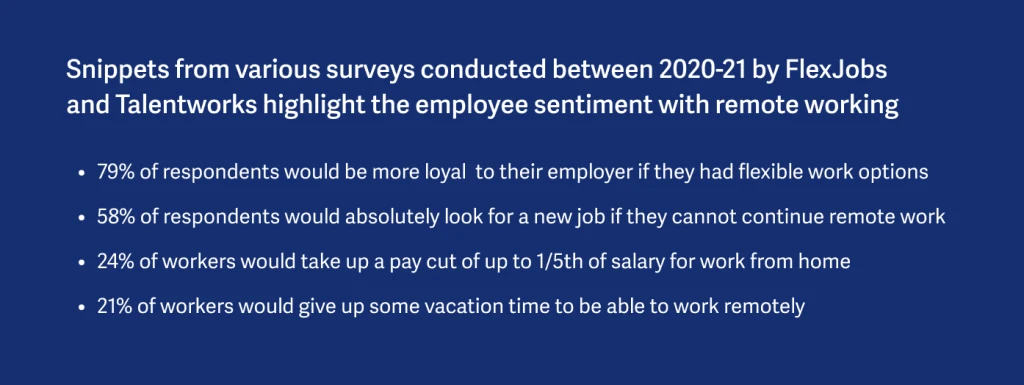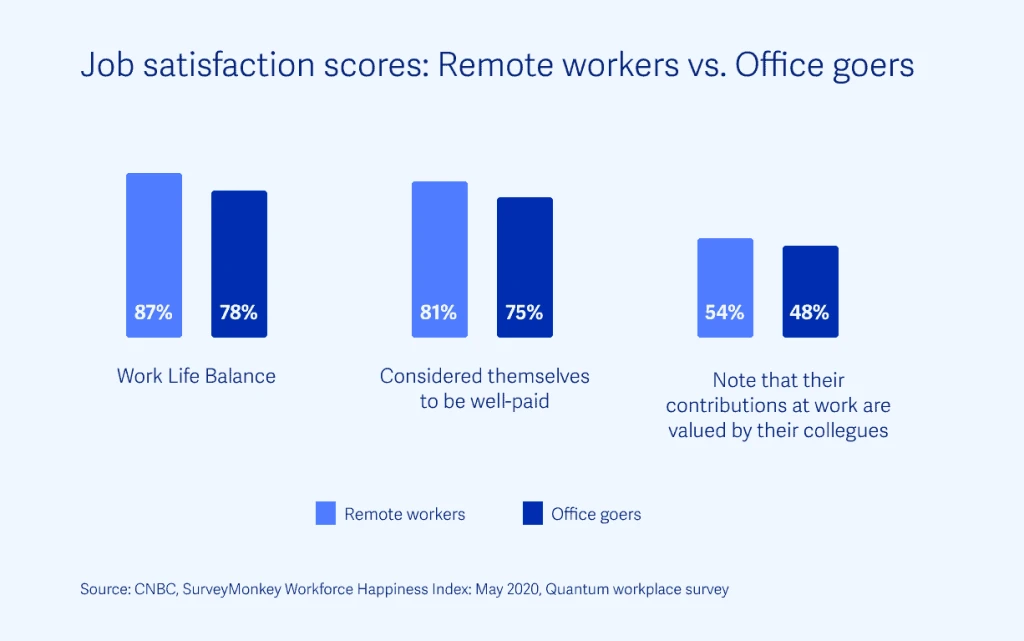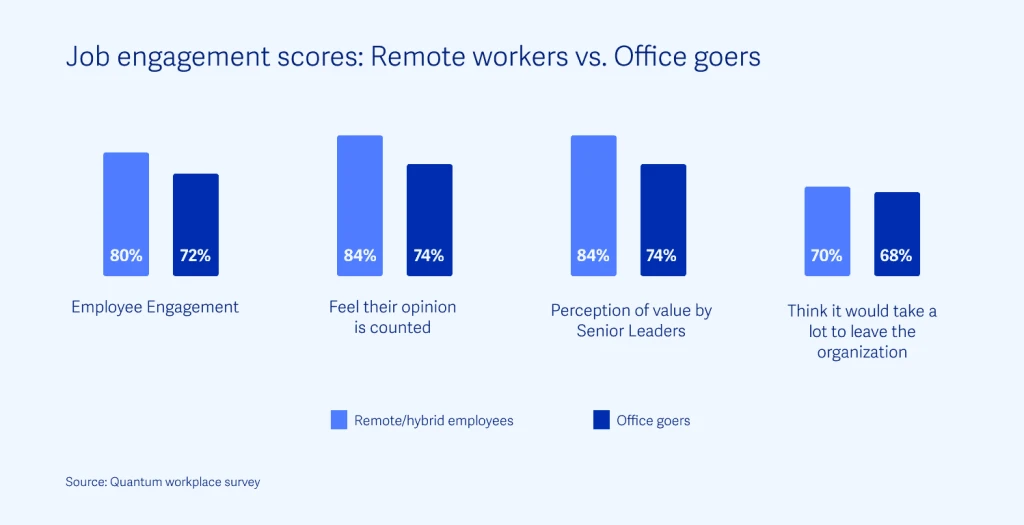When done right, telework can improve employee productivity, creativity, and morale.
The pursuit of happiness – who is happier working in the pandemic
The verdict is out – telecommuters are much happier than the regular office goers.
In December 2020, those working remotely reported a Workforce Happiness Index score of 75 out of 100, compared to 71 for in-office employees.

The same survey also found that remote employees were more likely to report being satisfied with their jobs than office-based workers (57% vs 50%). All in all, those working from home reported more positive measurements on almost every question related to job satisfaction.
Those who can do their job remotely are more likely to work full-time, to have a higher income, and to be employed in industries that have above-average rates of job satisfaction — all factors that bolster self-reported happiness at work.

Ok, so the remote workers are happy, but are they really working?
Not only do the remote workers feel happier, but they are also reporting better work productivity and job engagement levels.
A recent Stanford study found that working from home increased productivity among a group of workers by 13% over the course of nine months. Attrition rates were also cut by 50%, with employees citing a quieter, more convenient working environment as a major advantage.
Similar results were reported by Mercer, an HR and workplace benefits consulting firm. 94% of 800 employers surveyed by Mercer, said that productivity was the same as or higher than it was before the pandemic, even with their employees working remotely.
This is most surprising, as remote workers have been able to remain productive or increase their productivity levels even during the worst working conditions i.e. the pandemic.
The job engagement levels are also reported higher, enabled by the access to tools and technologies allowing the employees to better collaborate, and also enabled by an enhanced focus on the outcome, role clarity, rather than adhering and monitoring the process.

82 % of remote employees agree that they have the technology needed to stay connected to their manager and team when working remotely. When provided the right resources and equipment, remote employees can stay connected to collaborate with their team members.
Wait, but is remote working good for organizations too?
With the employees reporting better productivity and happiness levels, many companies are now planning a hybrid virtual model in which some employees are on-premises, while others work from home.
The new model promises greater access to talent, increased productivity for individuals and small teams, lower costs, more individual flexibility, and improved employee experiences.
Employee concerns, and what can organization do to support remote working?
Overwork and burnout
While productivity has gone up, many employees are also reporting being overworked, feeling like they are “always on” and having an inability to ‘disconnect’. Remote and hybrid work environments often make designating specific work times difficult, which can lead to overwork. The challenge is even more for employees juggling care for children or elderly, along with the work stress.
Remote and hybrid employees are more likely to report working over 50 hours a week compared to their on-site co-workers.
Anxiety about the future working model
Employees are reporting increasing anxiety about the future working model and policies in their organizations.
Based on a McKinsey survey, employees feel they have yet to hear enough about their employers’ plans for post-COVID-19 working arrangements, causing them anxiety.
Organizations may have announced a general intent to embrace hybrid virtual work going forward, but too few of them, employees say, have shared detailed guidelines, policies, expectations, and approaches. And the lack of remote-relevant specifics is leaving employees anxious.
Concerns about career advancement
One key factor pulling workers back to the office even if they might otherwise be more comfortable at home is career advancement.
More than half of workers (52%) expect those at their company who work in-person to have better career opportunities in the future than those who work remotely.
New collaboration tools like Zoom, Slack, and Microsoft Teams have made it possible for a dispersed workforce to collaborate on projects and attend meetings in much the same way that they would if they were all in the same building. Yet, there are some aspects of work that aren’t easily scaled digitally. Younger workers, who prioritize career advancement, are more likely to say they expect to be back in the office
Internet connectivity and IT support
Unstable internet connectivity and delays in getting IT support are some of the key issues faced by remote employees. Data security, customer confidentiality, IT troubleshooting, hardware and network support are some of the key areas for which employees are seeking a robust IT support. Many remote jobs encourage BYOD (Bring your own device), which further requires appropriate backend IT support.
What can organizations do to help?
- The leaders need to communicate more clearly and frequently with their employees — even if their plans have yet to solidify fully. Organizations that have articulated more specific policies and approaches for the future workplace have seen employee well-being and productivity rise. Sharing more with the employees also allows the easing of employee anxiety and burnout.
According to McKinsey, employees who feel included in more detailed communication are nearly five times more likely to report increased productivity.
- Organizations need to build a robust IT support remotely, incorporating stringent security protocols. A 24×7 support system can be built via a mix of Hub and spoke IT delivery models and doorstep IT services.
A robust technology support is required to enable better team collaboration and leadership connection. Technology adoption can also fill in the gaps required to enable career advancement opportunities at work.
-
Lastly, organizations also need to adopt appropriate Talent Management practices across the employee lifecycle to support the remote workers and their needs, leading to better engagement and retention levels. Refer to this article.
-
Organizations can have a list of co-working spaces that they can suggest to their employees with temporary internet connectivity issues or disruptions. They may subsidize the use of these spaces for urgent situations. These spaces usually have high-speed WiFi, IT support, and software to ensure their members have a conducive environment for productivity.
The quest for culture, and the way forward
As the employees go remote, organizations are struggling to translate their company culture into a digital space, which impacts connectivity between employees and their work. Leaders are facing the challenge of reimagining their culture for a world where rituals and ceremonies enacted in the office are inaccessible.
When Marissa Mayers, called off remote working for Yahoo quoting the need for ‘One Yahoo’ and better collaboration, it was a polar opposite step from today’s scenario where tech organizations are leading the way for remote working.
While remote working supports productivity; office connections and team collaboration enable brainstorming of ideas and creative problem-solving.
Productivity and creativity, in other words, can be polar opposites. So how to find a balance?
The first step is to acknowledge that the old, office-centric ways of reinforcing culture won’t work. Then, organizations need to be more intentional about establishing more touchpoints with remote employees, reimagining onboarding processes, and fostering inclusive ways of communicating.
An example here is Alibaba, which shifted some of their culture-building activities online. As a substitute for Aliday, historically a day-long company celebration, Alibaba North America hosted a remote quilt-making event where employees could come together and create “one quilt for each office to commemorate this special time,” thus reinforcing their values of community and collective activity.
Even fully remote companies like GitLab and Automatic rely on episodic in-person gatherings to rebuild bonds among employees and socialize new members.
Organizations will undoubtedly require a mix of practices that enable efficient, inclusive engagement while at the same time preserving aspects of synchronous and in-person activities that strengthen culture. Adapting to a hybrid environment will require some trial and error, but investing time and resources into new processes will ensure both employees and organization are able to thrive in a new era of work.
Read more:
